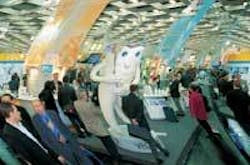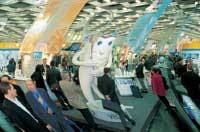To get the most out of an annual meeting, open your mind to the possibilities
by Mark E. Hyman, DDS, MAGD
Dental meetings provide doctors and their teams a good opportunity to learn new things, discover new technology and quite possibly, reinvent their practice to deliver an even higher level of patient care. In the first part of this article (February Dental Economics®), I talked about how to develop a plan so that you and your team can uncover the “big idea” that will grow your practice or enhance efficiency.
But once you return from the meeting, how do you integrate these ideas into your practice in a way that fires up your team and ignites production?
Bringing big ideas to life
All too often a doctor will attend an annual meeting and discover a new technology, program or service, and return to the team enthused but with no plan for implementation. Team members listen, nod, smile and think, “Just give him a week and he’ll calm down. Then we won’t have to change.”
Now if your team attended the annual meeting with you, implementing new ideas would be much easier, because each of them would bring back their own ideas. If you weren’t able to have your team go to the meeting, implementing new ideas needs to be done a little differently, which I’ll explain later in this article.
In the first article of this series, I stressed the importance of a proactive plan to get the most out of a meeting. I also recommended, before leaving for the meeting, scheduling a staff luncheon meeting within one week of returning to the office. It may be challenging to keep this commitment when you’re back in the real world, with the phone ringing, impressions being taken, and crowns that aren’t fitting. It is easy for the enthusiasm of the meeting to get lost in the day-to-day routine.
It becomes harder and harder to remember why you were so fired up about getting that CAD/CAM. You wonder why you were so excited about the digital camera that enables patients to “own their oral health problems.” This busyness is exactly why it’s so important to remember why you invested in the meeting in the first place - to enhance your delivery of care. So please, make the team meeting a priority.
When you bring the team together for the two-hour meeting, have each one that attended the show present at least one “big idea” they learned from the show. Have them explain why they believe the product or service will enhance the delivery of care or improve efficiency. Then filter all the ideas through the practice philosophy. When you ask the team if the new idea is in line with the philosophy, the answer may be “yes” or “not yet.” I am a big believer there are no “no’s,” only “not yets.”
When a team comes back excited and with new ideas, but the doctor says no, the doctor has the power to kill the team’s enthusiasm. So the doctor must give the team permission to make a wish list.
The team must be respectful of the practice budget, and they must be willing to do whatever it takes to help pay for the extra expense by raising the profitability of the practice. The team has to partner with the doctor and together, develop a plan to turn good ideas into “yes” ideas.
If the doctor was unable to bring his team to the annual meeting, introducing new, big ideas to the team requires a different approach.
Again, it starts with a team meeting within a week of the doctor’s return. At that time, the doctor asks the team for permission to introduce something new to the practice.
Then using all resources available, he or she “brings the exhibit experience to them.” For example, the doctor could invite a company rep to demonstrate a new product and re-create in the office the excitement the doctor felt at the show.
Allow the team to experience the sizzle firsthand, so they can feel the same level of enthusiasm the doctor has for the product or service.
Big ideas require training
I have found that the men and women of dentistry will invest in any piece of equipment to better the practice if the team is enthused and will use it. There’s nothing more frustrating than spending tens of thousands of dollars on technology and having it sit in the corner unused. Every office has a piece of equipment like this.
If the team has researched the product and the doctor has empowered them, the doctor buys the product and the team doesn’t use it, that’s just unfortunate. But if the doctor buys the equipment and does not train the team how to use it, that’s foolhardy. That’s the Achilles heel of dentistry - not taking time for training.
In Stephen Covey’s “7 Habits of Highly Effective People,” habit No. 7 is “Sharpen the Saw.” We have to take the time to sharpen our saw so we can perform better. In our office we do a monthly lunch and learn where we invite local reps to show us what’s new. Training must be a priority to ensure the smooth integration of any new idea, equipment or program into the practice. And it has to be a team effort.
If the doctor just spent $20,000 on intraoral cameras for the operatories, it’s a good idea to have the team come in on a Friday to take images of each other and get comfortable with the technology.
Working together to plan the training and integration will boost the team’s enthusiasm. This will give the team ownership and an investment in the success of the “big idea.” Winning practices come back from the annual meeting with laser focus, determined not to lose the big ideas that will revolutionize the practice.
Big ideas require action
Once the team has created a plan to implement a new idea in the practice and training is complete, the doctor must create consequences for action or inaction. I expect my team to join me as we all try to grow and be the best that we can be. We set goals and make plans to reach those goals.
If we all work together and exceed those goals and move the dial on production or efficiency, I share this good fortune with my team. This may take the form of bonuses, raises, more education or team-building events.
If a doctor invests thousands of dollars on an idea the team supported, then didn’t do their part to ensure its success, the consequence for this inaction should be documented in the annual performance reviews. Constructive discussions during performance reviews should be done in private. I use very specific language that allows the team member to engage and take ownership of his or her inaction.
For example, I might say, “There are things going on in this practice that make me upset. How do you feel about that?” If the team member doesn’t seem to care, it’s probably time for them to go somewhere else. If they care and want to change, I might continue like this: “Here is the behavior that’s upsetting me. As a team we agreed that offering payment plans would increase our production and improve efficiencies. We agreed we don’t want to bill patients anymore and have money disrupt our relationship with them. So I signed up with CareCredit, but you’re not using it. How can I provide additional training or tools that enable you to use the program the way we, as a team, agreed to do?”
Together we work out a plan for the team member to improve his or her performance. I’m a huge believer in ownership, listening and understanding.
Big ideas require change
One of the biggest benefits of an annual meeting is it allows you to stay current with new innovations. There’s a cliché, “If you keep on doing what you’ve always done, you’ll keep getting what you’ve always gotten.”
Unfortunately, this doesn’t apply to dentistry. If you keep doing what you’ve always done, you’ll get left behind, because dentistry is changing so rapidly. Innovation is driving dentistry and continuing education is not mandatory - it’s imperative. It’s our survival as professionals. And, it makes dentistry a whole lot more fun.
I love the reinvention of dentistry and I love working with a team that’s fired up about change. When you bring back big ideas from annual meetings, the synergy of the team working together and thinking of the possibilities must be nurtured and sustained. I’m smart enough to know that I’m not smart enough. But I hire people who have more talent and skills, and then I empower them and get out of their way.
Even if one of my team members brings back an idea I don’t fully understand, I give them my trust and allow them to prove me wrong. We all have different views of the world, and just because I don’t see things exactly like you doesn’t diminish the value of our visions. So invest in your team, take them to the annual meeting, let them see dentistry in a whole new light, and then as a team, develop the plan that turns a dream into your new reality.Dr. Mark E. Hyman is a renowned dentist and public speaker whose work is characterized by his warmth, enthusiasm, sense of humor, and passion for dentistry. A native of Greensboro, N.C., Dr. Hyman received his undergraduate degree from the University of North Carolina at Chapel Hill and his dental degree from the University of North Carolina School of Dentistry. Dr. Hyman has lectured throughout North America at major dental meetings, and has frequently been noted as a top speaker at his engagements. He can be reached by email at [email protected].

